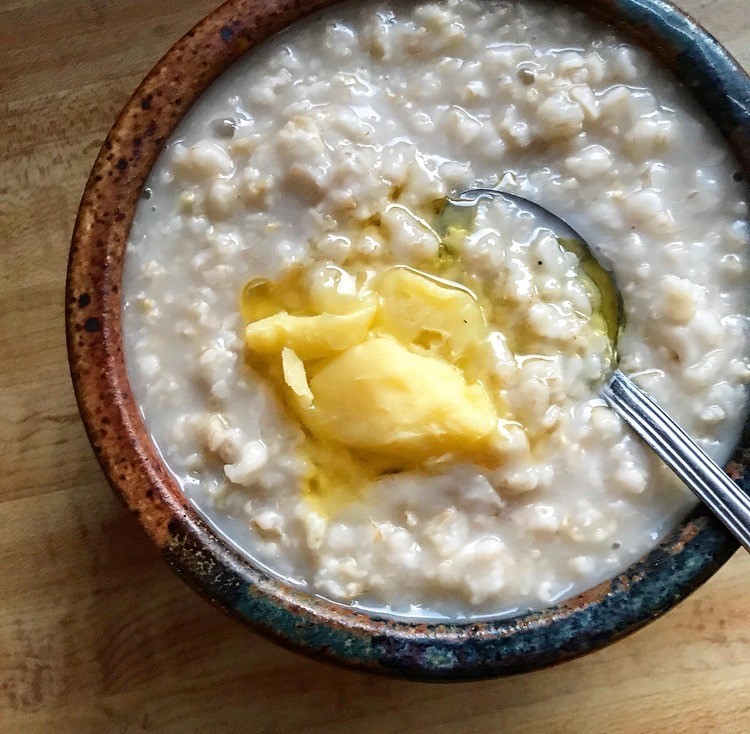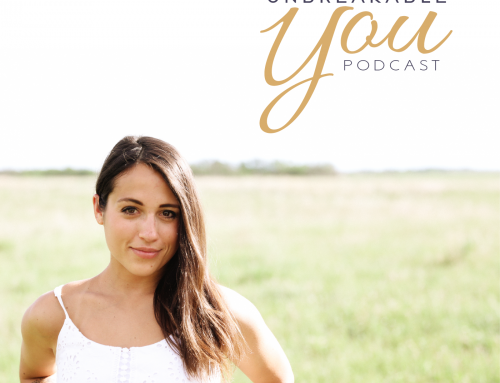If you know anything about me, you’ll know that I have more savoury teeth in my mouth than sweet.
That’s not to say your girl doesn’t like some chocolate every day, though. However, I do prefer dark chocolate. In my opinion, the darker the better.
With that said, ever since reintroducing oats into my diet last week, I’ve been loving bowls of savoury oatmeal for breakfast!
I know a popular way to top oatmeal is with cinnamon and brown sugar, but, like I said, I don’t have much of a sweet tooth (especially in the morning), so my ideal bowl of oatmeal is topped with a big glob on ghee and a sprinkle of sea salt.
Many people in the “paleo/real food/health world” often demonize grains, such as oats, because of the anti-nutrients they contain and also because they are not as “nutrient dense” as a bowl of, let’s say, sautéed vegetables, for an example.
However, if you read my post from last week, you’ll know that if you take the proper steps when preparing your bowl of oatmeal, you can reduce a large amount of the anti-nutrients (also known as phytate) while also activating an enzyme called phytase, which actually releases certain nutrients, making them more bioavailable!
Having said that, I completely understand how and why one would claim that a bowl of vegetables is more nutrient-dense than a bowl of oatmeal. However, there’s no reason to demonize any type of food. Oats, in my opinion, can be a part of a nutrient-dense diet and I have been loving incorporating them back into my diet after going five years without having them!
I do love increasing the nutrient-density of a meal whenever I can, though. So, when I have a bowl of oatmeal, I don’t just have a bowl of oats and nothing else. I always add some nutrient-dense goodies on top, such as healthy fats!
My current favourite oatmeal bowl combo includes a big glob of ghee and a generous sprinkle of sea salt! Not only does it taste absolutely delicious (honestly, it kind of reminds me of a bowl of buttered pasta!), but there’s also so many health benefits that those two simple ingredients offer and, since I’ve been getting asked so many questions about ghee lately, let’s chat about why you may want to top your morning bowl of oats with a big glob of ghee just like I do!
Health Benefits of Ghee
Ghee contains butyric acid, which is a short chain fatty acid that plays a critical goal in gut health as it has been shown to promote a healthy gut microbiome, fight inflammation and support those with conditions such as Crohn’s disease, ulcerative colitis, and inflammatory bowel disease. (1, 2, 3, 4, 5)
Ghee also contains CLA, which is short form for conjugated linoleic acid. This is a type of fatty acid known for it’s many health benefits, such as cancer prevention, improving body composition, addressing inflammation, and lowering blood pressure. However, it is important to note that CLA will be found in higher concentrations if your ghee is from grass fed cows, which is why it is so important to be aware of where your food is coming from and how the animals you consume have been raised. (6, 7, 8, 9)
Ghee is rich in fat soluble vitamins, such as vitamins A, E, and K. Vitamin A is known for the role it plays in hormonal balance and fertility, while vitamin K is needed to transport calcium into our bones. Fat soluble vitamins are necessary for so many areas of our health and ghee is an easy way to include them into your diet regularly!
Ghee is casein and lactose free, so most individuals who are lactose intolerant or follow a dairy-free way of eating can incorporate ghee into their diet without any issues! Ghee is made by clarifying butter, which means butter is heated up and the milk solids that float to the top are skimmed off in order to make ghee – clarified butter!
Ghee has a high smoke point, which means it is a stable cooking fat and will not oxidize when heated. Plant oils, on the other hand, such as canola, sunflower, and safflower oil, are not stable cooking fats and become oxidized when heated, which are then toxic to our cells.
Ghee tastes like a better version of butter! In my opinion, ghee is even better than butter! If you’ve never tried ghee before, imagine a caramelized, almost nutty version of butter – that’s what ghee tastes like! Some of the best ghee’s I’ve tried are St. Francis, Organic Valley, and Pure Indian.
Now that you know the health benefits of ghee and why you may also want to top your oatmeal with it, it’s time that I share my recipe with you!
- 1/2 cup raw rolled oats
- 2 cups water
- 1 tsp raw apple cider vingear
- Sea salt, to taste + extra for finishing
- Ghee, for topping
- At least 24 hours prior to serving, add oats, water, and apple cider vinegar to a pot and place over medium high heat. Season with sea salt, stir, and bring to a boil.
- Once it begins to bubble, remove from heat, and cover.
- Allow the oats to soak for 24 hours covered on the counter or stove top.
- After 24 hours of soaking, heat oats until warm, remove from heat, and transfer to a serving bowl. Top with ghee and extra sea salt.


